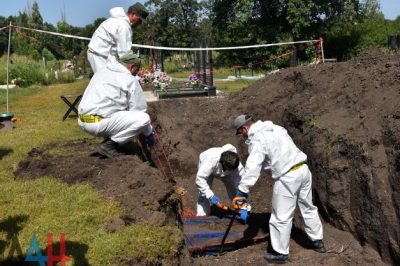OSCE Remains Silent Despite Uncovering of Ukraine’s Mass Killings in Donbass

All Global Research articles can be read in 51 languages by activating the “Translate Website” drop down menu on the top banner of our home page (Desktop version).
To receive Global Research’s Daily Newsletter (selected articles), click here.
Visit and follow us on Instagram at @crg_globalresearch.
***
Over a thousand victims of Ukraine’s military aggression against Donbass were discovered in unnamed graves. From the summer to the present, an active search for all victims of the Ukrainian military and their allied Far-Right militias has been underway, culminating in the creation of a joint committee which includes representatives of the Donetsk (DPR) and Luhansk (LPR) People’s Republics, investigators, forensic experts and others. Investigations into the mass graves will form the foundation of a future tribunal against Kiev. Collected dossiers of Ukraine’s war crimes in Donbass have already been transferred to international authorities.
There is colossal work that needs to be carried out in Donetsk. Since 2014, about 130 burial places of missing persons have been discovered. It is not known how many more there are. According to Daria Morozova, head of the commission for the search of missing persons in Donetsk, more than 3,000 claims have already been sent to the International Criminal Court in The Hague.
“There is information that the documents have been accepted for consideration and included in the evidence base,” Morozova said.
According to the head of the DPR forensic medical examination bureau Dmitry Kalashnikov, the investigated graves contain people who died during the Ukrainian military’s artillery shelling. However, there are also remains of people with traces of torture and bullet wounds perpetrated by the Far-Right militias.
“There were cases when people came and knew by their names those who were buried in unknown graves, but they had no death certificates. In such situations, children cannot receive survivor pensions and other social benefits,” Kalashnikov said.
In Luhansk, teams are also continuing to search for victims of Ukrainian aggression. Seven out of 17 discovered mass graves were investigated, 300 bodies of the dead were exhumed and almost 400 people donated blood for DNA examination. The remains of many victims were reburied in November at a cemetery in Luhansk, where a memorial complex is being created.
Anna Soroka, chair of the interdepartmental working group on the search for burials in the LPR, said: “the enemy went so far as to prevent the burial of the dead, cemeteries were mined, people could not send their loved ones on their final journey.”
“As for tortured civilians from the graves, if the places of these graves are put on a map, then they fall on settlements that have been under the control of the so-called Ukrainian ‘volunteer battalions.’ We have information where they were based. It is there that the bodies with traces of torture and execution are located,” she added.
Donbass residents also submitted burial site examination results to the European Court of Human Rights and the International Criminal Court. The Commission managed to establish communication with private groups of Ukrainian volunteers and human rights defenders who are looking for missing persons on Kiev-controlled territory.
Meanwhile, Kiev’s authorities completely ignore the Donetsk and Luhansk initiative to establish cooperation in this area. The reasons for non-cooperation are clear: the perpetrators of aggression do not want to admit crimes and be held accountable. Therefore, Kiev is blocking all proposals for a joint search of missing persons and mass graves.
Of the international organizations and bodies, only the Red Cross provides assistance in exhuming bodies in Donbass. Although the OSCE has all necessary information and records, visit morgues and mass graves, and document violations and take photographs, their published reports are emasculated and their conclusions biased.
This manipulation of information was assessed by LPR representative Andrey Marochko: “I have read all their reports from 2015 to this day. […] In general, drafts of OSCE reports leave Luhansk in voluminous terms, and already from their office in Kiev, fairly cleaned up versions are published. […] Sometimes even journalists recorded the mistakes of the OSCE mission representatives who saw violations, but this was not reflected in the reports.” As an example, Marochko cited how an OSCE representative was captured near a Ukrainian tank, but this tank was not listed in the report.
After the kidnapping of Luhansk observer Andriy Kosyak, the Joint Center for Control and Coordination issued a number of statements for the OSCE to influence the terrorist-like behavior of Ukraine. There is still no reaction from the European mission even though a month and a half has passed since the abduction of the Luhansk observer by Ukrainian saboteurs. As a result, the OSCE mission is limited in movement across LPR until Kosyak is released.
In order to break the obvious information blockade, the DPR and the LPR are creating a special site, “The Tragedy of Donbass”, to collect data on Ukrainian war crimes and on those missing. The project aims to process and organize data and provide access for the general public to collate stories of survivors and victims. Just as importantly, it will also provide the names, ranks and other information of Ukrainians suspected of committing crimes against humanity, including mass killings.
Although this resource will assist in highlighting Ukraine’s war crimes, true accountability cannot be made until the OSCE is depoliticized and carries out the work it is expected to do in an apolitical manner. However, there is little evidence that this will occur in the short-term.
*
Note to readers: Please click the share buttons above or below. Follow us on Instagram, @crg_globalresearch. Forward this article to your email lists. Crosspost on your blog site, internet forums. etc.
Paul Antonopoulos is an independent geopolitical analyst.
Featured image is from InfoBrics

